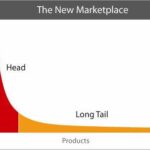In the old days, companies would do extensive research to try to predict what the market would buy. Once they felt that they had a good idea about what would sell and how much of it they would need, they would build a product line to produce it and develop a strategy to deliver it. Once they could offer the product or service, they would rely on the marketing department to sell it using advertising. In the old days, companies had to produce a product or service that they would sell to the masses just to justify the enormous expense to get it to market. Due to high expense structures, unit costs only reached the price point where consumers would buy them when they could allocate the design and distribution costs across many thousands of units.
Today, manufacturing and distribution costs have come down, especially for products that can be delivered online. Consequently, consumers no longer want mass-produced, one-size-fits-all products. Chris Anderson wrote about this market shift which he called The Long-Tail in his book of the same name. The marketplace is shifting away from producing undifferentiated, mainstream products sold to the masses to highly differentiated, niche products sold to a relatively small market segment. In the old economy, advertising was essential to market a product to the masses. It was considered effective to spend lots of money producing a flashy T.V. ad and play it over and over again in what we call “interruption marketing.” Since consumers back then were limited to only a few T.V. channels and there were no such things as DVR’s, this technique worked just fine.
Today, this technique is entirely ineffective even for the traditional mass marketed products and even more so for niche products. Today, we have hundreds of channels and most homes have a DVR that allows viewers to record programs and skip over commercials. Therefore, old marketing ideas based on advertising are far less effective today than they use to be.
Today, we live in a new economy where interruption marketing, such as T.V. commercials and ads, has been replaced by permission marketing. Permission marketing is where consumers engage with or seek out content they consider valuable for their specific situation. The new marketing paradigm uses social media marketing and SEO to attract their audience rather than pushing a product or service on consumers.
Rather than selling what a company can produce, a company today needs to produce products or services that they can sell based on their ability to reach their audience.
Rather than employing an inside-out model where the company predicts a product’s features, companies today need an outside-in model where the company can attract and work with the customers to define their product’s features. Advertising to the masses is inside-out marketing while using social media and content to attract their audience is outside-in marketing.
Today, many entrepreneurs are still captivated by the idea of producing a one-size-fits-all, home run product they can sell to the masses. However, they use social media marketing, an outside-in tool to market it because it is all the buzz and everyone else is using it. Moreover, nascent entrepreneurs with a niche product turn to old inside-out marketing tools like advertising to try to sell their product and go bankrupt in the process.
Advertising is appropriate for undifferentiated, mass-produced products while social media marketing is more appropriate for products or services that are highly differentiated and live in the long-tail marketplace.
Should you be using inside-out or outside-in marketing to sell your product or service?












